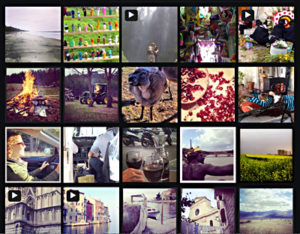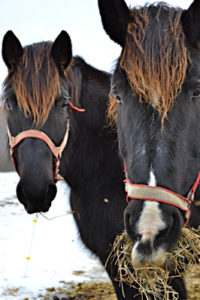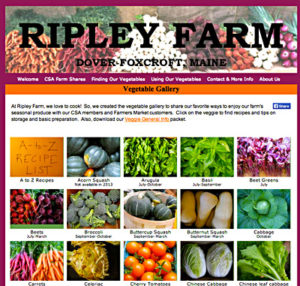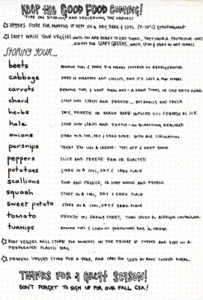 |
| Broadturn Farm posts photos on Instagram, Facebook and on its website for maximum exposure to social media. Photos courtesy of Broadturn Farm. |
How can you connect with customers through social media? Farmers highlighted their storytelling strategies at a marketing session at MOFGA’s 2013 Farmer to Farmer Conference.
Stacy Brenner and John Bliss of Broadturn Farm in Scarborough grow MOFGA certified organic vegetables to about 180 CSA members and to some retail and wholesale customers, and they sell cut flowers through a flower CSA and for events, including weddings. They also host weddings at their farm. Their communication tools include these:
https://www.broadturnfarm.com/ – This site includes their blog.
https://www.facebook.com/pages/Broadturn-Farm/141029388206
https://instagram.com/florabliss (https://instagr.in/u/florabliss)
https://www.meetyourfarmer.org/broadturn-farm/ – A short film by Maine Farmland Trust about Broadturn Farm
https://www.taprootmag.com/ – Brenner writes for this magazine.
“What are we selling with our story?” asked Bliss. “You’re always selling your brand. Storytelling is the most powerful form of marketing we have access to.”
You can tell your story in depth through a newsletter, such as Sprouting Acres’ at https://www.sproutingacres.com/blog, and essays, such as https://www.ladybugletter.com/?p=138. Broadturn’s blog enables them to tell their story in some depth, while Facebook, Instagram and Pinterest tell a shorter story.
These stories should be positive, said Bliss – even in a wet year like 2009, with its rampant late blight, although Brenner added, “Personality is the most important element. Readers want to be with you through your hard times … emotional openness” is important. In 2009 they highlighted their new kittens to contrast with the bad weather. Another post showed them building their interns’ housing. They try to blog weekly during the growing season and less often in winter.
 |
| Draft horses are part of the story and allure of North Branch Farm in Monroe. Photo by Elsie Gawler. |
“Photos are central to our story,” said Bliss. “The text is just a few words. The real meat is the photos.”
Regarding photos, “I can’t stress enough how great the iPhone is,” said Brenner. “It takes incredible pictures, short videos, and you can post them immediately. The way water comes off your lettuce when you’re washing it, the sunlight … make a 5-second video [and] they’re going to want that lettuce.” She said posting videos through Instagram is easier than through Facebook.
Morning and evening – the “magic hour” of light – make nice shots, Brenner continued, and rainy days are great for interesting tones. Close-ups and details are always admired. “All that broccoli sitting in the back of the truck – there’s your hard work right there. It’s beautiful, all in one place. Remember what you are trying to sell.”
Photos of people working are also powerful.
“Get a good camera and a smartphone as part of your business expense,” said Brenner, and use Facebook and Instagram. “I take the phone, snap a shot, Instagram it and Facebook it at the same time.” She links Facebook posts to their blog.
Instagram (instagram.com) is a free way to post photos and short videos for your followers. “You have a fun opportunity to add filters,” said Brenner. Instagram “doesn’t necessarily increase your local sales,” she added, “but we’re looking for destination wedding people.”
An iPhone app lets you add text to a photo for Instagram, said Brenner. For instance, they may use a banner on an Instagram photo to advertise for help with their flower business.
“Farmers are observant,” said Bliss, “and have unlimited material to work with. We’re working with our hands. The people following us are spending a lot of time at a computer or have jobs in town” but want to be working with their hands. “We’re filling that experience gap.”
According to https://blog.bobbyrettew.com/tag/gen-x/ the current workforce includes 75 million baby boomers, 50 million Gen X-ers (born in the ‘60s-‘80s) and 70 million Gen Y-ers (born between 1980 and the early 2000s). Gen C (for “connectedness”) spans age groups and includes those who embrace digital media. (See https://www.briansolis.com/2012/04/meet-generation-c-the-connected-customer/) Bliss said Gen Y will be the bulk of their customers in a few years.
Think of these groups when telling your story, said Bliss, and be sure your story has truth, personality, plot and continuity (as described, for instance, at https://www.forbes.com/sites/work-in-progress/2013/02/05/5-secrets-to-using-storytelling-for-brand-marketing-success/).
Their Portland customers, Bliss continued, “are taking on the characteristics of that younger generation,” which has been described as yuppies with a protagonist identity. “They have the idea that they’re the most special person they know” … that they’re “a unique main character of their own story. We see this persona in a lot of our interns – the ‘me’ generation. If your life isn’t that exciting or interesting, you latch onto other people’s stories that are. That’s what Facebook is about – linking other people’s stories to yours.” That “Facebook image crafting” builds your identity and pushes your brand, said Bliss.
 |
| Ripley Farm’s Vegetable Gallery and recipes page is the most popular part of its website. Photos courtesy of Ripley Farm. |
Broadturn’s posts don’t always relate to vegetable or flower products. “Sometimes it’s political,” said Stacy. “We may lose a few customers but we get more positive [than negative] feedback.”
In addition to the blog part of their website, static pages give the back story for the retail store, the farm, the farmers and their products. “Always have an easily accessible back story for new readers,” said Brenner.
When using social media, “It helps if you can engage yourself with a young person,” said Brenner. Their 17-year-old daughter set up their Instagram account and explained its etiquette. Many of their CSA members use Instagram, so Brenner photographs their produce while making dinner and tells followers, “Here’s what I’m making with the share.” She hashtags the name of their store and flower business so that their followers see and link to their posts. (A hashtag is a # symbol placed immediately before a key word so that posts relating to that word are categorized and searchable.)
“The ripple effect is helpful for us,” said Brenner.
“Your dream come true,” said Bliss, “is to have a dozen of your CSA members taking a picture the evening they take their share home, showing how they’re using it.”
Regarding others telling your story – filmmakers, photographers, journalists – Brenner said to be open but cautious. Maine Farmland Trust’s short “Know Your Farmers” video of their operation “turned out great,” while “another piece for a network news station took 2-1/2 days for 1 millisecond of national TV that did not affect our sales. We have since said ‘no’ to a lot of such media. Widespread attention doesn’t make your potatoes more valuable, and interviews take a lot of your time. Now if someone wants to do an interview, I say email me your questions and I’ll email my answers back. That way you know exactly what you said. Say you want to see the piece before it’s printed.”
Brenner is cooling to Pinterest, where “people create boards with a topic, such as ‘flowers in the spring that I love’ or ‘Mason jars with flowers on a runner of burlap.’ If you’re on a website, you can click a picture and it goes to Pinterest. People find a photo on the Internet, pin it on their board and share that board with me. I have all my brides send me their Pinterest link” if they have one. “We look at these when making up arrangements.” The problem: The photos are “almost all the same – as if your ideas were getting taken. It creates no originality. I don’t populate my Pinterest board any more.”
Farmer to Farmer participant Anna Mueller noted that many people link Pinterest to their Facebook and Instagram pages so that when they pin something, it appears on all three.
Mary Margaret Ripley and her husband, Eugene, raise vegetables at their Ripley Organic Farm in Dover-Foxcroft and sell through their CSA, at the Orono Farmers’ Market and wholesale. They tell their farm story at
 |
| Its windmill logo links Sylvester Manor to its past and to its community. Illustration courtesy of Sylvester Manor. |
https://www.ripleyorganicfarm.com/ and
https://www.facebook.com/RipleyFarm.
“It’s easy to think that if you can grow nice vegetables, they’ll be able to sell themselves,” said Mary Margaret. That’s what she and Eugene thought when they started their farm in 2009.
“We grew a lot of nice vegetables but had trouble selling them all. The good news is that “people really do want to buy your stuff. Our job as farmers is to convince them that they can do that and to show them how easy it is to do that. That’s where telling your farm story comes in. And one of the best ways to tell your farm story is online.”
To craft that story, Mary Margaret said to ask
• What is your goal or purpose in using social media?
• Who is your audience and why do they care?
She offered these general tips:
• Always use images. Document everything you’re doing, then you can put it on your website and Facebook page. Ripley had a Farmer to Farmer participant photograph her while speaking so that she could show followers that she had presented at the conference.
• Be professional and excited about farming and your business.
• Do periodic “online farm tours” to get ideas based on other farm sites.
And she offered specific tips for websites:
• Use your website as your foundation, or “home,” for online marketing. Her site, built with Drupal (a free site), “is the main place where we’re telling our farm story. Everything else should refer back to it.” The first year of doing their CSA, they had 16 members and no online presence. The following year, with a website to promote their CSA, membership jumped to 40, and the following year to 60. They think they are shooting for 80 in 2014 and have added an online sign-up option this year. They found, through surveys, that the top reasons people support their CSA are quality and freshness, to support local farmers, and to know where their food comes from. “So we use those … in our storytelling,” including a blog with lots of pictures on their website. “We’re telling our story that we are a local farm that can be supported, and we can show you where your food comes from, if you want to buy from us.” Regarding quality and freshness, “One of the best ways to portray that is with pictures,” said Ripley. Their online vegetable gallery – their most popular page – shows the vegetables they grow and their quality and provides recipes for each. This helps retain CSA members. Another tab tells CSA members when to expect different vegetables in their CSA box and basic ways to retain freshness.
 |
| The current enthusiasm for hand lettering is alive and well on Sylvester Manor’s website. Graphic courtesy of Sylvester Manor. |
• Be in charge of managing daily activity on the site and make that easy to do.
• Navigability of the website is important. Make sure your most important points (e.g., CSA info) are very visible and accessible.
• Use pictures! This is a place to boast about your product!
• Always keep in mind your goals with using social media when creating content and making other website decisions.
Regarding Facebook – “an arm attached to the main body of your marketing, your website,” Ripley gave these tips:
• Always use your Facebook and other social media outlets as a way to get people to your “home” on the Web that you control – because you don’t have control over Facebook’s policies, but you do control your website.
• Keep in mind your goals and make sure your content satisfies those goals. For Ripley, that means increasing connection with and retention of CSA members, and creating and maintaining a buzz about their farm in order to expand their CSA. “We tell people that we are growing the food that they want to buy – by talking about the things they care about.” For example, they tell the story that they have the best quality produce by posting photos of quality, fresh, beautiful produce. “Nothing sad or upsetting,” said Ripley. They link back to their website for recipes. They portray “knowing where your food comes from” through photos of activities on the farm, e.g., planting garlic. “One member wants to see that we’re not ‘industrial.’” The planting photo does that. “We remind people we’re at farmers’ market this week and what we have and how they can order it to pick up on our farm.” Humor helps – such as a photo of Gene holding the largest rutabaga of the season. They always post a picture of the week’s CSA share.
• Post between 8 a.m. and 9 p.m., when people are awake.
• Use the scheduling option (the clock icon on the bottom left of the Facebook status update) over the weekend for posts during the week. Ripley takes pictures throughout the week and uploads and schedules them on Sunday. “I can be in the field all week and Facebook’s working for me and I’m working for myself.”
• Post at least one time per day to maintain interest in your page.
• Have an image with everything you post so that people will stop to look at it in their feeds.
• “Like” other farms, businesses, organizations, etc., and look through your business news feed for ideas for future posts.
• Sign up as a personal page so that you can interact better with your farm page and other business Facebook pages. She signed up as “Chester Carrot” for a personal page, and then created Ripley Farm. This allows more interaction with people on your page – e.g., to “like” what they’re saying and to comment on other business pages. You can’t do this if you sign in as a business page.
Ripley surveyed her CSA customers by putting a paper survey and a self-addressed stamped envelope with the last CSA share of the season. She got 75 percent response. This year she is trying Survey Monkey online. “I have yet to attain the same results, but it’s free.”
This year, when she asked her CSA members about the farm’s marketing, 75 percent said the recipes and website were very helpful to them in using the contents of their CSA box; 61 percent said their Facebook page made them feel very connected to what was going on at their farm. Past surveys showed most people find their CSA and sign up through word-of-mouth, so increased satisfaction with the CSA through their website and increased connection through their Facebook page translate to increased word-of-mouth, which should provide continued CSA growth.
Regarding surveys, Edith Gawler added that Google Form Builder on Google Docs is a good survey tool, collecting answers in a clean spreadsheet. You can link to the survey from Facebook and from a website.
Elsie Gawler and Anna Shapley-Quinn publicize their North Branch Farm in Monroe at
https://www.facebook.com/NorthBranchFarm.
Elsie Gawler advised growers to have a camera on hand all the time.
Among websites to consider are Blogspot (free), WordPress (which she uses, paying $4 per month), Weebly and Squarespace.
Anna said that because they have a lot of family businesses, their Facebook page has about 400 likes – although that’s difficult to translate into sales. When Elsie posts on Facebook, Anna shares that on her personal page, then friends share it, and the message escalates.
They started the blog to share family photos with distant relatives and ended up posting about the farm. People (including the media) find them because they have a lot of text about their farm from the past four years, and they have information about horsepower.
They use WordPress, which, Elsie said, made it easier to get the look she wanted.
Draft horses help on the farm and with marketing. A silhouette of horses appears on their business card, for example, and customers seem to enjoy that. “It makes for beautiful, romantic pictures that you don’t always get with a tractor,” said Anna.
They think the best storytelling for farmers is still person-to-person. “We’re always excited about what we’re doing. We’re talking about it and let people know there is more information on the Internet – but ultimately it’s still about people and personal contact.”
‘Have fun with it,” said Elsie. “We’re always excited about what’s happening on the farm and want to put that out there.”
Edith Gawler publicizes Sylvester Manor Educational Farm on Shelter Island, N.Y., through
https://www.facebook.com/SylvesterManor?ref=hl and
https://twitter.com/sylvestermanor.
Edith met Bennett Konesni when he inherited proprietorship of Sylvester Manor, which has been in his family for 360 years. His vision was to turn the 243-acre property into a nonprofit educational farm.
A farmer, designer, musician and future homesteader, Edith has a background in architecture and is skilled in WordPress, website building, design narrative, design process, Illustrator, InDesign and Photoshop.
She is using those skills to help publicize Sylvester Manor – to preserve its history, documents and legacy; to offer arts programs, workshops and educational programs to the community; and to highlight its CSA, begun in 2009.
Making such a diverse set of stakeholders feel like they’re being communicated with directly, without having multiple identities, is challenging. They are two hours from New York City, so cultivating donors is a huge part of their operation. They also want to capitalize on their many volunteers, as well as their many visitors and program attendees. And they want to be part of the local community – some 10,000 summer residents on the 8,000-acre island. They also want to be involved in today’s “incredible” networking movement of young farmers, and of historians and researchers.
Their windmill logo helps, as it symbolizes their heritage of a hand-built, quality agrarian life and a community institution where everyone on the island once came to mill grain.
Edith originally did all the farm’s communications herself – website, Facebook, Twitter, brochures, photos, graphics, T-shirts, signage, etc. Now she coordinates a team.
She did the website’s front end in Photoshop and worked with a development firm to implement the back end, using a WordPress custom theme. “It’s very easy to manipulate our custom website. Several staff members can edit it.
“Before you start to tell your farm story, you need to understand that story yourself,” said Edith. “How you communicate it defines who you are to [your audience]. You may think you’re something completely different than some people see you to be.”
Branding is so important, said Edith, so take your time with these questions: Who are you? How are you unique? Embrace your uniqueness and use it to set yourself apart.” She sees Maine as an amazing place with a huge movement of farmers, “but we have to make sure we’re all not doing the same thing. Are you the only one doing what you’re doing, or are you trying to get a foothold in an established market. Who are your stakeholders? Who is already naturally interested in what you do? Do you have experience with wholesale, retail, weddings, education? What are your favorite things about what you do? Answer all these questions and develop your brand first, because rebranding is really difficult.
“Communicating your farm story can be as simple as you want it to be. How much time are you willing to commit to recurring communications, like writing blog posts, taking photos, doing Twitter? There are tricks, like writing things in batch and then having them post at different times.
“If you have really limited time, do things to set yourself up, like investing in a rubber stamp and plastering your logo everywhere. Just get yourself out there.”
Once you have your brand and your plan, you need consistency. “Be recognizable. Be loveable. Think of everything you do as communicating. How your carrots are topped can tell people a lot about who you are as a farm and what you stand for.
“Beyond consistency, make sure it’s coherent and adaptive. Don’t design yourself into a corner. Embrace that unique and weird thing about you, whatever it is, and get people excited about it. Gather your team together, which is crucial. Who is available where and to do what? Who do you enjoy working with and communicating with regularly? Survey everyone involved with your farm to find out who has what skills and how much time can they allot to each thing? Do you have writers like Anna? Anna is an amazing writer, and was able to communicate through North Branch’s blog. Are you a painter? Work that in somehow. Elsie does amazing paintings of beautiful vegetables.” Use illustration if possible, and quality photos.
“Handwriting, lettering – that sort of handmade quality really speaks to the farming movement at the moment.”
To post hand-lettered work, Edith said you can scan the paper or photograph it with a smartphone, import and clean it up in Illustrator, then post it. “I have so many sketch books, and I use the illustrations and notes I take.”
“Do you have an intern who loves Instagram? Take advantage of that.
“Who has a great sense of humor? Have them write your Twitter posts.
“Start small. You don’t need to do everything all at once. Look at your strengths and start there. Look at your network – family, friends, neighbors, customers … and barter. Whoever is doing the task, give them full ownership of it. Expect great things and they’re likely to happen. Have clear expectations and clear boundaries.”
Schedule the time for communications. “In farming, the work is never done,” said Edith. “If you feel like communication is going to be a big part of your farm, make sure you schedule in the time to do that.”
Perception is also important. “You have to look as if you have your act together and, even more importantly, as if you’re having fun. Enjoy what you’re doing. A lot of us aren’t farming to make a million and retire early but to live the good life. Part of communicating your farm story is sharing that good life with everyone. When people are eating your vegetables and they’ve seen your beautiful blog, they’re not just tasting that carrot; they’re tasting that whole agrarian scene that grew that carrot, and it’s really this whole beautiful, romantic thing that happens.”
One of Sylvester Manor’s farm interns this summer had great handwriting, had fun lettering, so produced lettering for graphics for their CSA. Gawler mentioned Andrew Plotsky’s Farmrun (farmrun.com) as an example of incredible hand lettering and videos with a great sense of humor. Eliot Coleman also has a good graphic identity and a great personal brand – “He knows exactly who he is and what he stands for.” Others with strong identities are the National Young Farmers Coalition, Slow Food, the Beehive Collective, Stone Barns Center and The Greenhorns.
Gawler uses WordPress because it’s easy to incorporate a blog. She was able to make the site user-friendly for first-time visitors, and as recurring visitors go deeper into the site, they get more information – about the manor, its history, the farm’s CSA, WWOOFERs, the farmers’ market, work-song workshops, summer programs and special events, including an annual farm-to-table dinner (their biggest donor event). Their recipes are all tagged and hand-illustrated, and CSA and farm stand customers have latched onto Gawler’s artwork.
“Take that little extra time if you enjoy illustrating, handwriting, or know someone who does,” said Gawler, as the response has been strong. To enable searches, put key words in the body of the blog or use the image and a typed version of a recipe or post below it.
For events, a WordPress plug-in called Events Calendar Chrome enables visitors to see everything that’s going on in calendar view and get more information in list view.
Discussion
Farmer to Farmer participant Tom Roberts of Snakeroot Farm said they update their website in winter, because they don’t have time in summer. They update Facebook when they have a chance. “If we’ve got a good story or a good picture, it’s worth putting on the Facebook page,” but “I think just looking at pretty pictures gets old pretty quickly. I don’t know the story.” Their website has a “what’s new” feature, he added, “because there’s so much on there – this makes it easier for people to find new posts.”
Brenner said, “We go back and forth between image-centered and word-centered posts, depending on the time available. My daughter says her friends don’t read. Our parents like to read and hear things about the farm. We’re trying to appeal to both.”
Roberts noted that judging the effectiveness of promoting a farm by print, radio or TV can be as difficult as judging the effectiveness of social media.
Edith Gawler said Twitter can be helpful if you have a fresh product available for a short time – for example: “Fresh donuts today!”
Regarding the fact that MOFGA’s Facebook audience is mostly women in their 30s to 50s, a participant noted that Maine has had an increase in young farmers, and the majority are women. That skewed audience “might be to our benefit,” said Brenner: “Women make most of the food choices.” Ripley said most of their farm, CSA and PYO flower customers are women, and Roberts said the same is true at farmers’ markets. Participant Anna Mueller said women tend to network more, so are an important audience.
Asked whether to post bad news stories, such as those relating to pink slime or antibiotic resistance, Roberts responded, “It’s negative about people who don’t grow stuff like you do. Just link to stories and say you offer an alternative.” Another participant suggested posting a beautiful picture of your farm one day, linking to the bad story the next day and featuring a recipe using your products the following day.
To help market meat products, “I’ve got to be photographing that roast when I take it out of the oven, or those vegetables,” said a participant. To do that, Brenner said to clear off the table and set the scene with the beautiful roast with natural light coming in. “Look through Bon Appetit and see how they depict meat,” she said, adding, “I move my bottle of whiskey out of the way…” Ted Quaday suggested creating a 45-second video of prepping meat for cooking.
Brenner hesitates to open videos on Facebook, because they may be 5 minutes long, but on Instagram they’re only a few seconds long, “and you get the audio, which is hugely powerful.”
Elsie suggested posting comments on other farms’ Facebook pages, as “all your followers will see it. If you just ‘like’ a post, they won’t. Take advantage to contribute to the discussion going on in the community.” Brenner added, “If I see something interesting on North Branch Farm, I click ‘share,’ and all my followers see it.” Ripley said that feature is not possible on a business Facebook page.
Regarding Twitter, Elsie said, “If you know a lot of your customers use Twitter, I recommend using it.” Post something like, “Our first harvest of broccoli is now at our farm stand.” You can link Twitter with Instagram and Facebook so one photo is posted to all three.
Another participant noted the ability to use “Tweetups” to call people to action – to testify for legislation, for example, or discuss strategy.
Edith said, “Wit is the most important tool with Twitter, because you have only 140 characters.” She had an intern who was good at this and generated a lot of traffic to their farm.
Roberts said he spends a lot of time engaging his customers in a conversation “so that they don’t see me as a vending machine but as a person they can connect to. That makes me realize that if you try for bonding, sales will follow; if you try for sales, you sound like you’re trying to sell something.” He uses his website to offer detailed information – e.g., instructions on building a greenhouse out of logs from the woods. People thank him for the information. “For every one thank-you, probably 100 people are grateful but didn’t thank me. Emailing one-to-one and conversations at farmers’ markets are probably the most important communications I do; others – the newsletter, Facebook – are more like direction signs. Think of the farmers’ market or the farm stand as media, too. The experience people have at the point of sale will determine whether they come back or not.”
Edith agreed. “It’s great to get people in but you have to get people to stick. Offer something really educational so that people feel like they’re becoming a better person.” That human connection is key, she said.
– J E
